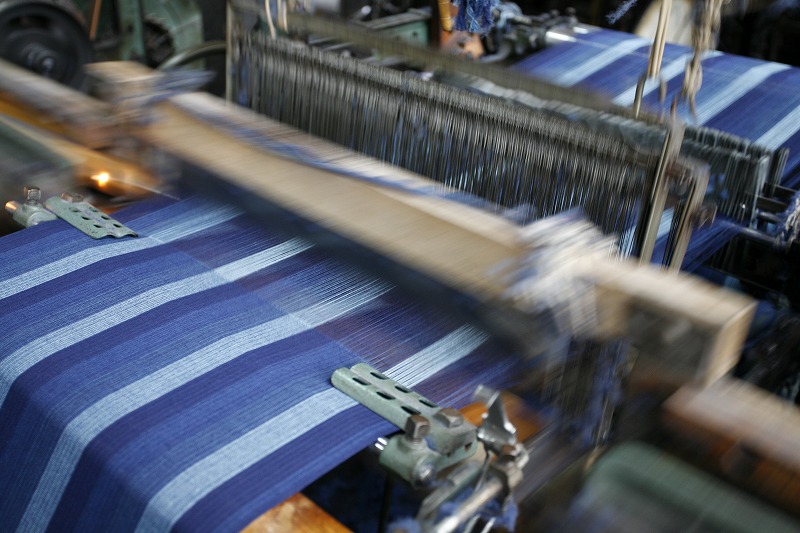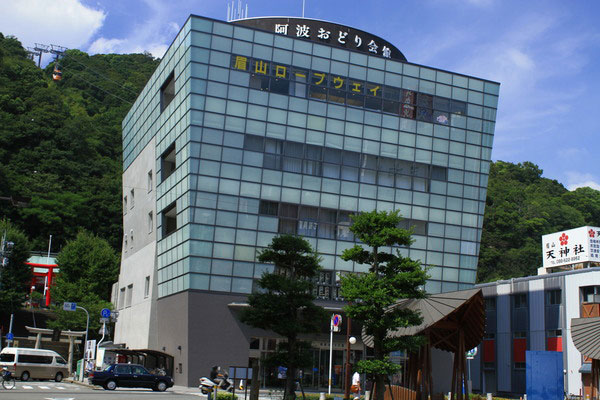
- Woven textiles
- Tokushima
Awa-shijira cotton cloth Awa shoai shijira ori
Traditional cotton fabric
dyed with high quality Awa indigo
Description
What is Awa-shijira cotton cloth ?
Awa Shoai Shijira Ori is a cotton textile produced in Tokushima City, Tokushima Prefecture. Shijira Ori had been produced in Awa since the 18th century, and the Shijira Ori dyed with Awa indigo was referred to as Awa Shoai Shijira Ori. It was designated as a traditional craft by the Japanese Minister of Economy, Trade and Industry in 1978. Shijira means the fine wrinkles on the surface of the textile, similar to the chijimi. The characteristic of Awa Shoai Shijira Ori is the overall embossed effect created by the fine wrinkles, which is referred to as shibo. The embossed effect creates a lightness and texture that feels good on the skin when worn. It also prevents the fabric from sticking to the skin when perspiring, so it is very popular as a fabric that keeps one cool during the hot summer. The plain cotton texture and the indigo color, which is referred to as "Japan blue," are the attractive features of Awa Shoai Shijira Ori. It is mainly used to make yukata, a casual cotton kimono, which is worn from summer to autumn. Recently, the textile is also used for making accessories, including ties and handkerchiefs, as well as interior goods such as tapestries. Anyone can appreciate the charms of Awa Shoai Shijira Ori in their everyday lives.
History

Awa Shoai Shijira Ori started in 1866. Hana KAIFU, who lived in Ataka, Myodo-Gun, Awanokuni (Ataka, Tokushima-City today) accidently came across the Shijira Ori technique. Hana was drying the cotton fabric that was called the Tatae Jima, which was popular among commoners in Awanokuni at that time, when it started to rain and the fabric shrank. Hana found the wonderful embossed texture of the shrunken fabric. That made her think about making the cotton fabric with fine wrinkles, shibo. After that, Hana made a great effort to develop the technique to make Shijira Ori with the shibo using different tension in the threads. The inexpensive, light and cool cotton fabric was widely accepted by the commoners and became widespread in Awanokuni. As Hachisuka, the fuedal lord of Awanokuni, encouraged the cultivation of indigo, Awa indigo was planted along the Yoshino River from the mid-Edo period (1603 - 1868). The production of Awa indigo accounted for approximately a quarter of the total production of indigo in Japan until the Meiji period (1868 – 1912) started. The Awa indigo dye is a high quality dye for cotton, so it was used for Shijira Ori, too. Even after the indigo industry declined, Awa Shoai Shijima Ori continued to be popular for casual wear and it is preserved as a traditional industry in Japan as of today.
General Production Process
- 1. Winding threads into a skein The threads are wound into a skein. A special device is used to wind the threads onto a frame to make a skein. In this way the threads are gathered together, making dyeing easier.
- 2. Dyeing The skeins are dyed in a special pot for dyeing skeins. The longer the threads have been soaked in the dye, the deeper the color becomes. The threads are dyed in various colors using not only natural indigo but also chemical dyes.
- 3. Washing in water The dyed threads are washed in water. Awa indigo requires washing repeatedly until the natural color appears.
- 4. Drying in the sun Funori, which is a glue used in Japan for textiles, is applied to prevent the threads from becoming fluffy while they are dried in the sun. Oxidation occurs in the indigo dye when it is exposed to the air and the color becomes more beautiful. The indigo dyeing process requires the repetition of the cycle of dyeing, washing and drying in the sun.
- 5. Winding the threads The dyed threads are wound around a reel from the skeins to prepare for weaving.
- 6. Warping and preparing the weft The warp threads are sorted into the required number of threads and the length for the loom. The weft threads are put through a shuttle that is used for weaving.
- 7. Weaving The weaver starts weaving. The warp and the weft are pulled with different tensions while weaving in order to create the shibo. For this reason, the combination of the threads for paralleled yarn is different from that of plain weaving.
- 8. Drying and finishing The textile shrinks as it is soaked in hot water and the shibo appears. The finished textile is dried and the production of Awa Shoai Shijira Ori is completed.
Where to Buy & More Information
Tokushima Bussan Kanko Koryu Plaza"Arudeyo Tokushima"

-
Address
-
Tel.+81-88-622-8231
-
ClosedDecember 28 to January 1
-
Business Hours9am to 8pm
-
Website
See more Woven textiles
- Nishijin brocade
- Yuki tsumugi silk
- Kurume traditional resist-dyed textiles
- Ojiya chijimi textiles
- Hakata brocade
- Ushikubi tsumugi silk
- Chichibu-meisen silk
- Miyako ramie textile
- Shiozawa tsumugi silk
- Kumejima tsumugi silk
- Omi ramie cloth
- Ryukyu traditional resist-dyed textiles
- Kiryu brocade
- Murayama-oshima tsumugi silk
- Yumihama traditional resist-dyed textiles
- Chibana-hanaori textiles
- Hon-shiozawa silk
- Oitama tsumugi silk
- Ojiya tsumugi silk
- Yaeyama cotton cloth
- Yaeyama ramie cloth
- Honba oshima tsumugi silk
- Shinshu tsumugi silk
- Shuri brocade
- Tama brocade
- Yomitanzan-hanaori textiles
- Isesaki traditional resist-dyed textiles
- Hachio island silk
- Nibutani bark cloth
- Uetsu tilia bark cloth
- Awa-shijira cotton cloth
- Kijoka banana fiber cloth
- Tokamachi traditional resist-dyed textiles
- Tokamachi akashi chijimi textiles
- Yonaguni brocade
- Yuntanza minsa
- Flower pattern textiles
- Oku-Aizu Showa Karamushi Textiles































































































































































































































































































